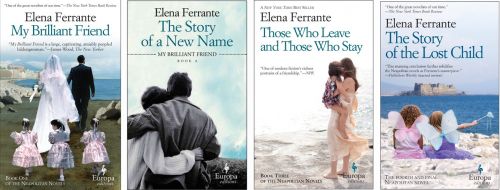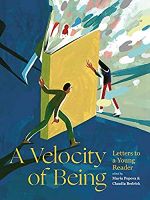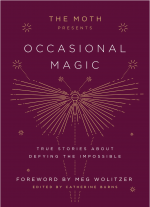What I'm Reading: May 2019
May 24, 2019 at 8:50 PM
Here are the books I’ve read and especially admired in recent months, October 2018 – April 2019
- Astrophysics for People in a Hurry by Neil deGrasse Tyson, nonfiction, popular science
- Go, Went, Gone by Susan Bernofsky, fiction
- There, There by Tommy Orange, fiction
- The Library Book by Susan Orlean, nonfiction
- A Moveable Feast by Ernest Hemingway, fiction stories
- Housegirl by Michael Donkor, fiction
- Dear America: Notes of an Undocumented Citizen by Jose Antonio Vargas, nonfiction
- Almost Everything: Notes on Hope by Anne Lamott, advice essays
- A Velocity of Being: Letters to a Young Reader by Maria Popova and Claudia Bedrick, eds. Letters of reading encouragement, with illustrations by multiple artists and graphic designers
- City of Light: the Making of Modern Paris by Rupert Christiansen, nonfiction
- Ten Poems for Difficult Times by Roger Housden, poems by 10 poets with commentary by Housden
- Why Religion? A Personal Story by Elaine Pagels, memoir
- My Brilliant Friend by Elena Ferrante, fiction (Book 1 of the Neapolitan Novels)
- The Story of A New Name by Elena Ferrante, fiction (Book 2 of the Neapolitan Novels)
- Those Who Leave and Those Who Stay by Elena Ferrante, fiction (Book 3 of the Neapolitan Novels)
- The Story of the Lost Child by Elean Ferrante, fiction (Book 4 of the Neapolitan Novels)
- Aristotle’s Way: How Ancient Wisdom Can Change Your Life by Edith Hall, nonfiction, philosophical guide
- Homegoing by Yaa Gyasi, fiction
- Where Reasons End by Yiyun Li, fiction
- The Wisdom of No Escape and the Path of Loving Kindness by Pema Chödrön, guide to living
- Women Rowing North: Navigating Life’s Currents and Flourishing As We Age by Mary Pipher, personal essays
- The Moth Presents: Occasional Magic: True Stories About Defying the Impossible by Catherine Burns, ed., personal stories
- Epitaph For a Peach: Four Seasons on My Family Farm by David Mas Masumoto, memoir
- In Praise of Slowness: Challenging the Cult of Speed by Carl Honore, persuasive nonfiction

While I found all of the fiction on the list excellent, my favorites are the four books in the series known as the Neapolitan Novels. Beginning with Book 1, My Brilliant Friend, all the way through to the end of Book 4, The Story of the Lost Child, I was mesmerized. I inhaled these books, so much so that I read all four over a one-month period during which the main characters, best friends Elena Greco (known as Lenú) and Lila Cerullo (known as Lila), lived in my head daily. No matter what I was doing they were with me; I knew their most intimate thoughts. I’ve never read books quite like these. Through Elena as the narrator of the stories, the author makes visible Lenú’s and Lila’s innermost thoughts, feelings, and actions in a manner I’d never before experienced. The slow pace, the mesmerizing detail, the strong sense of place, and the vivid interior monologues all serve to illuminate the powerful relationships between these two women from childhood through late middle age.
These stories begin post World War II in a Naples ghetto and encompass the ever changing social, emotional, economic, and political landscapes of loyalty, love, betrayal, violence, heartbreak, revenge, jealously, adversity, kindness and more—in other words, the full human condition and how it is impacted by who holds the power. As Ferrante makes clear in a fascinating essay, “Power is a Story Told by Women” (New York Times, Sunday Review, May 19, 2019), she sees storytelling as a kind of power that we need to assume with responsibility and good intentions. She also advocates for a female vision of power where women’s storytelling becomes a prominent path for confronting and resolving local and worldwide issues. “The female story, told with increasing skill, increasingly widespread and unapologetic, is what must now assume power.”
The Neapolitan Novels, which have been beautifully translated from the Italian by Ann Goldstein remain at the top of bestselling book lists in Italy. Treat yourself, especially with summer coming up. Find a quiet spot where you won’t be interrupted, slow down, and give yourself over to the power of story. It does take a while to “get into” My Brilliant Friend, but stick with it, and go for reading the whole series. While it can be tricky to keep track of all the characters (you need to refer often to the various family charts at the beginning of each book), even when that’s difficult to do, don’t worry; you won’t miss the important threads of the stories. These books are storytelling masterpieces. In fact, HBO has adapted and dramatized the series to high acclaim.
 Two other books on the list are standouts; they are not to be missed! First, all K-12 educators, families, and lovers of books will want to have a copy of the gorgeous A Velocity of Being: Letters to a Young Reader by Maria Popova and Claudia Bedrick, editors; if you don’t get a personal copy, at least get a copy for your classroom and/or school library. A Velocity of Being is that good and that inspiring! It’s a knockout! The editors invited people they admired from all walks of life—artists, writers, scientists, musicians, philosophers, entrepreneurs, cultural heroes, and more “to share their stories and sentiments about how reading shaped them.” They received 121 letters--“the poetic, the playful, the deeply personal.” Each letter to a Reader discusses how reading impacted their lives, in some cases how reading saved them and made them feel part of the human race. Each letter is accompanied by a beautiful, full-page illustration by 121 talented artists. I have read this collection multiple times and savor it more on each reading; I have read aloud many of the letters to students, teachers, and administrators, and listeners are always enchanted.
Two other books on the list are standouts; they are not to be missed! First, all K-12 educators, families, and lovers of books will want to have a copy of the gorgeous A Velocity of Being: Letters to a Young Reader by Maria Popova and Claudia Bedrick, editors; if you don’t get a personal copy, at least get a copy for your classroom and/or school library. A Velocity of Being is that good and that inspiring! It’s a knockout! The editors invited people they admired from all walks of life—artists, writers, scientists, musicians, philosophers, entrepreneurs, cultural heroes, and more “to share their stories and sentiments about how reading shaped them.” They received 121 letters--“the poetic, the playful, the deeply personal.” Each letter to a Reader discusses how reading impacted their lives, in some cases how reading saved them and made them feel part of the human race. Each letter is accompanied by a beautiful, full-page illustration by 121 talented artists. I have read this collection multiple times and savor it more on each reading; I have read aloud many of the letters to students, teachers, and administrators, and listeners are always enchanted.
It is noteworthy that all royalties from the book are being donated to the editors’ local New York public library system “because libraries are bastions of democracy and oxygen for the life of the mind . . . our single most ferocious frontier of resistance to inequality and injustice.” You also might want to check out Maria Popova’s brainpickings.org for her insightful essays and blogs on culture, philosophy, love and living a worthwhile life.
 Another rave goes to The Moth Presents: Occasional Magic: True Stories About Defying the Impossible by Catherine Burns, editor. I’ve been a devoted Moth fan since I discovered this wonderful non-profit organization, dedicated to the art and craft of live storytelling, without notes. Most stories are told in under ten minutes, which requires much preparation and practice. Occasional Magic includes about 50 short, true stories that were originally told in front of a live audience. The book’s dedication page reads: “To the Stories That Give Us Perspective, Clarity, and Hope.” I have loved reading one or more stories at bedtime, during the day when I had just a short bit of free time, or aloud to a group of educators.
Another rave goes to The Moth Presents: Occasional Magic: True Stories About Defying the Impossible by Catherine Burns, editor. I’ve been a devoted Moth fan since I discovered this wonderful non-profit organization, dedicated to the art and craft of live storytelling, without notes. Most stories are told in under ten minutes, which requires much preparation and practice. Occasional Magic includes about 50 short, true stories that were originally told in front of a live audience. The book’s dedication page reads: “To the Stories That Give Us Perspective, Clarity, and Hope.” I have loved reading one or more stories at bedtime, during the day when I had just a short bit of free time, or aloud to a group of educators.
The Moth was created and named in 1997 by novelist George Dawes Green, who wanted to re-create “the feeling of sultry summer evenings in his native Georgia, when moths were attracted to the light on the porch where he and his friends would gather to spin tales.” (p. 347, About The Moth). See themoth.org for the Moth’s offerings, including but not limited to national and international oral storytelling events, workshops, competitions, podcasts, radio shows, and The Moth’s Education Program for high-school students, college students, and educators. For more information see also, “Want to know the secrets of great storytelling? Ask The Moth.” (Seattle Times, March 17, 2019, “The Mix”, E. 5.)
Adding Moth storytelling to high school classrooms would go a long way to valuing and validating students’ histories, cultures and lives. Consider having students tell personal stories about what matters most to them, i.e., the plot about an experience that had deep meaning for the student plus the feelings the storyteller has/had about what happened. Such storytelling has the power to build community and break down walls between people by making public our shared humanity. It’s why it was so important to me to include many personal and professional stories in Literacy Essentials: Engagement, Excellence, and Equity for All Learners (Stenhouse 2018.) I wanted my readers to know me better so they would feel they could trust me-- the ideas, practices, research, and actions I was presenting and advocating for. Without trusting relationships, risk taking and openness to meaningful change are unlikely to occur.
Commentary: Reading as Respite
The same way I find cooking for pleasure and baking relaxing, a time when I do not focus on how long it will take, what mistakes I might make, or looking for the “perfect recipe,” reading provides a similar pleasure in that I slow down, really slow down, and just savor the pleasure of the process, the giving myself over to being fully present in an activity I enjoy--without concern for meeting a deadline, understanding every detail, or meeting someone else’s expectations. I have set the goals and standards for myself and chosen what I want to create and what I want to read. It’s liberating!
So it must be for our students. We must not forget amidst the noise of standards, high stakes testing, and the push for the “science of reading” that reading for enjoyment, choosing texts that are relevant to us, gaining new knowledge on topics of interest, and taking pleasure in all of it as a whole—not in bits and pieces and isolated skills—is a human right. So do what you can to create a reading culture of respite for yourself and your students. Consider as a classroom teacher or as a principal starting off the day with everyone reading a self-chosen text—and let’s include all school members—the secretaries, custodians, parents who might happen to be there, lunch crew, librarians. Some of those self-chosen texts might be class-authored and student-authored. Imagine the stress flowing out of all involved by starting the day on a quiet, slowing down, breathing easy, deciding what you want to read and how you want to read it.
To keep reading as respite, we have to make it a priority. There is never enough time, but how we choose to spend our time shows what we most value. Perhaps, most of all when we devote sustained time(s) each day to uninterrupted reading—and make it the mainstay of any reading program or curriculum--we are validating the importance of a love of reading, curiosity, and all the peace and joy reading a self-selected text can bring. As noted in the Introduction by Maria Popova in A Velocity of Being, reading “will remain an elemental hunger” because “the dignity and authority” of the written word can never be replaced by technology and new inventions. With that in mind, be cautious about how much record keeping and writing we are asking students to do related to their reading. For the past 20 years, I’ve been keeping a reading log, where each month I list the books I’ve read (title, author, and genre), and I put a star next to those I have found outstanding. That’s it. I love having a simple record of my reading over the months and years; it’s my reading history and a crucial part of my life. Students also like keeping their own reading history, as long as they—with our guidance—get to decide the format and what is included.